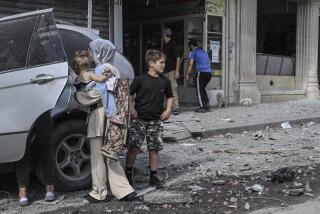Assassination backlash
- Share via
There is no denying that 2011 has been a banner year for taxpayer-funded assassinations — Osama bin Laden, Anwar Awlaki, five senior Pakistani Taliban commanders in October and many more. Given the crucial U.S. backup role in Libya, and the ringing exhortation for the Libyan leader’s death issued by Secretary of State Hillary Rodham Clinton just before the event itself, we can probably take a lot of credit for Moammar Kadafi’s messy end too.
Once upon a time, U.S. officials used to claim that we were merely targeting “command and control centers,” rather than specific individuals, as in the hunt for Saddam Hussein during the 1991 Persian Gulf War or the raid on Kadafi in 1986. Nowadays no one bothers to pretend. Successful assassination missions, whether by elite special forces or remote-controlled drones, are openly celebrated.
Clearly, the sentiment prevalent among our leaders is that eliminating particular enemy leaders is bound to have a beneficial effect. Thus in our recent wars, the U.S. has made the pursuit of “high-value targets,” the principal objective of so-called human network attacks, a priority. “The platoon’s mission is to kill or capture HVTs,” recalled Matt Cook, a sergeant in the 101st Airborne based in northern Iraq in 2005. “That is all we do.”
By 2008, according to a U.S. Strategic Command study, our military was simultaneously engaged in no fewer than 285 human network attack programs.
So, now that assassination is an official tool of U.S. foreign policy, along with trade embargoes and overseas aid, it is surely time for an open debate on whether it is indeed effective. Surprisingly for some, evidence based on hard numbers demonstrates unequivocally that the answer is no.
The numbers are derived from a study conducted in Iraq during the “surge” campaign of 2007-08 that enabled the U.S. to declare victory and wind down the war. Key to the surge was an intensive and ruthless hunt for key individuals in the “IED networks” that were organizing homemade bomb attacks against U.S. troops. Cause and effect — more dead network leaders leading to fewer bombs — seemed so self-evidently obvious that nobody bothered to check.
Early in 2008, however, Rex Rivolo, an analyst at the Counter-IED Operations/Intelligence Center attached to U.S. headquarters in Baghdad, briefed his superiors on some hard realities of the campaign. With access to any and all information relating to U.S. military operations in Iraq, he had identified about 200 successful missions in which key IED network individuals had been eliminated. Then he looked at the reports of subsequent bomb attacks in the late insurgent leader’s area of operation. The results were clear: IED attacks went up, immediately and sharply. One week after the hit, on average, incidents within about three miles of the dead leader’s home base had risen 20%.
Why, with the commander dead, did the enemy fight with such reinforced vigor? Eliminated enemy commanders, intelligence revealed, were almost always replaced at once, usually within 24 hours. “The new guy is going to work harder,” Rivolo told me. “He has to prove himself, assert his authority. Maybe the old guy had been getting lazy, not working so hard to plant those IEDs. Fresh blood makes a difference.”
Once posited, this consequence may appear obvious, but Rivolo’s study, so far as I am aware, was the only time that anyone with access to relevant data had looked at the consequences of our principal national security strategy in a systematic way. However, even as he submitted his conclusions, the same strategy was being exported to Afghanistan on a major scale. Ever-increasing special forces “night raids” have indeed subsequently succeeded in killing large numbers of insurgent commanders (along with many civilians), but the consequences have been depressingly predictable.
“I used to be able to go talk to local Taliban commanders,” a journalist long resident in Afghanistan told me, “but they are all dead. The ones who replaced them are much more dangerous. They don’t want to talk to anyone at all.”
Nongovernmental groups similarly report that the new breed of Taliban leadership is unwilling to allow the free passage of aid workers permitted by their assassinated predecessors. Neither in Afghanistan nor Pakistan, where high-value targets are the responsibility of the CIA’s burgeoning killer-drone bureaucracy, is there any indication that the enemy’s military capability has been diminished.
As Matthew Hoh, the foreign service officer who quit in protest at the futility of the Afghan war, told me recently, “War is a breeding ground for unintended consequences.”
President Obama should think about that.
Andrew Cockburn is an investigative journalist and author. His article, “Search and Destroy: The Pentagon’s Losing War Against IEDs,” appears in the November issue of Harper’s magazine.
More to Read
A cure for the common opinion
Get thought-provoking perspectives with our weekly newsletter.
You may occasionally receive promotional content from the Los Angeles Times.






